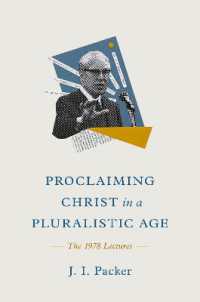- ホーム
- > 洋書
- > 英文書
- > Literary Criticism
Full Description
How might we understand early modern sexuality prior to contemporary interpretations of sexuality? What does the sex life of James VI and I tell us about the history of sexuality?
Jason O'Toole explores the network of intimacy which structured itself around King James VI and I, his wife Anna of Denmark and James' prominent as well as ancillary favourites to provide answers to these questions. O'Toole presents a cultural and literary history of homoerotic desire by analysing the politics and texture of queer culture at the Jacobean court.
To uncover this history, he investigates how physical manifestations of desire reveal themselves through intimacy between physical bodies and through the handling, employment and exchange of material bodies and objects. Objects which simultaneously represent accepted and forbidden desire. Highlighting how same-sex desire was often concealed, O'Toole evaluates how literary works from the period communicate an unnamed desire between men through metaphor, allegories and Classical allusions. Primary texts including poems, masques, and unpublished manuscripts, recurrent tropes, material culture such as artistic artefacts and architectural design are analysed to unpack sexual double meanings and demonstrate how homoeroticism acts as a regular and accessible subtext. This focus illustrates how homoerotic and homosocial desire were both interwoven and normative in the courts of King James VI & I, foregrounding the social, cultural and political importance of same-sex desire in the early modern period.
Contents
Introduction
Chapter I: James and his Phoenix, Lennox
Chapter II: James and his Queen, Anna of Denmark
Chapter III: James and his Ancillary Favourites, Montgomery and Carlisle
Chapter IV: James and his Volatile Favourite, Somerset
Chapter V: James and his Most Powerful Favourite, Buckingham
Conclusion
Notes
Appendix
Bibliography
Index








